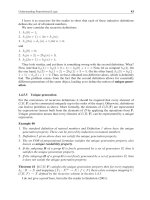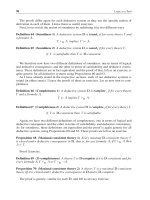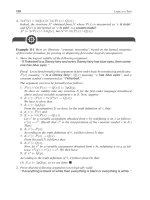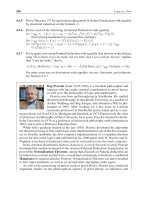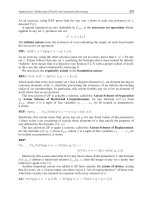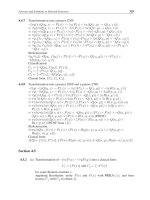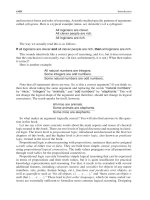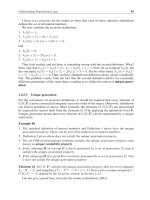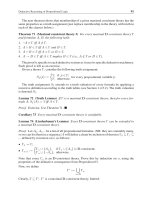Logic as a tool a guide to formal logical reasoning ( PDFDrive ) 321
Bạn đang xem bản rút gọn của tài liệu. Xem và tải ngay bản đầy đủ của tài liệu tại đây (60.63 KB, 1 trang )
Answers and Solutions to Selected Exercises
297
(r) There is a real number x such that, for every real number y , x is greater than
y or −x is greater than y . False.
(t) There is a real x such that every real y greater than x will have a square also
greater than x. True: take for example x = 1.
(w) For any real number x, there is some real number y so that xy will equal yz
for all real numbers z . True: given x, take y = 0.
(y) Between any two distinct real numbers there lies another real number. True:
density of R.
3.2.6 .(b) No natural number is greater than 6 or not greater than 5.
False: for example, 0 falsifies the claim.
(d) Every natural number that is not greater than 4 is not greater than 3.
False: take x = 4.
(f) Every natural number that is not 1 or 31 is not a divisor of 31.
True: 31 is a prime number.
(h) For every natural number x there is a greater number which is less
than or equal to any natural number greater than x.
True: every natural number has an immediate successor.
(k) For every natural number x there is a natural number z that is greater
than x and less than every natural number greater than x.
False: take any x. Then whatever z such that x < z is chosen, take y = z .
(l) If for every natural number x, the property P holds for x whenever
it holds for all natural numbers less than x, then P holds for every
natural number.
True: this is the principle of (complete) mathematical induction.
(n) Every non-empty set of natural numbers (the interpretation of the
predicate P ) has a least element.
True. Suppose that for some interpretation of P in some set X ⊆ N it is the
case that X has no least element. It can then be proven by induction that no
natural number belongs to X , and therefore X must be empty.
In fact, the property above is equivalent to the principle of mathematical
induction.
3.2.7 .(a) “Every father knows all of his children.” False.
(c) “There is no woman who does not know any of her children.”
False: there are women who have no children. They (vacuously) do not know
any of their children.
(e) “Every man is the father of every child of his.” True.
Section 3.3
3.3.1 .(b) ∀x(¬I(x) → x2 > 0)
(d) ∀x(I(x) → ∃y (I(y ) ∧ (x = y + y ∨ x = y + y + 1)))
(f) ∀x(I(x) → ∃y (I(y ) ∧ x < y ))
